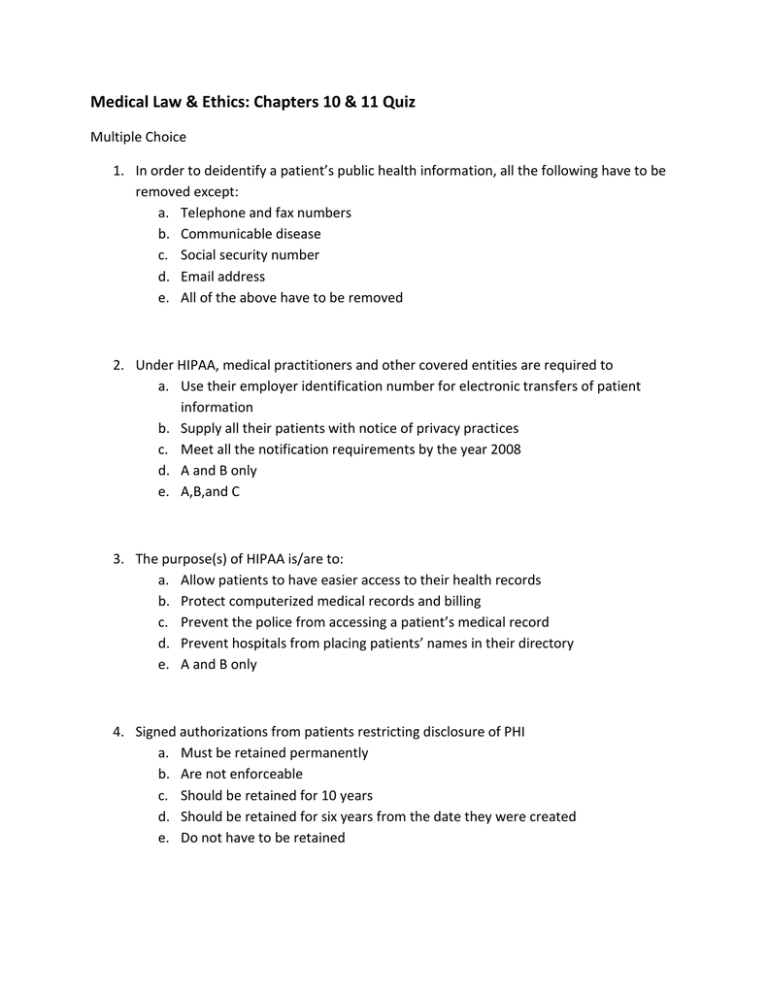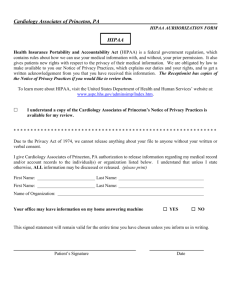Chapters 10 & 11 Quiz
advertisement

Medical Law & Ethics: Chapters 10 & 11 Quiz Multiple Choice 1. In order to deidentify a patient’s public health information, all the following have to be removed except: a. Telephone and fax numbers b. Communicable disease c. Social security number d. Email address e. All of the above have to be removed 2. Under HIPAA, medical practitioners and other covered entities are required to a. Use their employer identification number for electronic transfers of patient information b. Supply all their patients with notice of privacy practices c. Meet all the notification requirements by the year 2008 d. A and B only e. A,B,and C 3. The purpose(s) of HIPAA is/are to: a. Allow patients to have easier access to their health records b. Protect computerized medical records and billing c. Prevent the police from accessing a patient’s medical record d. Prevent hospitals from placing patients’ names in their directory e. A and B only 4. Signed authorizations from patients restricting disclosure of PHI a. Must be retained permanently b. Are not enforceable c. Should be retained for 10 years d. Should be retained for six years from the date they were created e. Do not have to be retained 5. A privacy officer should a. Be appointed by every covered entity b. Should be trained to receive complaints c. Should be trained to provide information concerning the provider’s privacy notice materials d. A and C only e. A, B and C 6. People and organizations that require a patient’s health information include a. Police b. Selected family members c. Insurance companies d. Ambulance services e. All of the above 7. Under HIPAA, a patient cannot have his or her name removed from a hospital patient registry. a. True b. False 8. Compliance with HIPAA has been relatively inexpensive for the covered entities such as Blue Cross. a. True b. False 9. The privacy rule that went into effect on April 14, 2001, grants a five-year period for compliance. a. True b. False 10. Under HIPAA, nursing homes have the right to deny access to patient’s medical information. a. True b. False 11. Medical device companies have no rights under HIPAA to a patient’s medical information. a. True b. False 12. Vital healthcare information, such as a patient’s case of venereal disease, can be supplied and still be in compliance with HIPAA. a. True b. False 13. The penalties for noncompliance with HIPAA are relatively mild. a. True b. False 14. Under HIPAA, patients can request to be contact only at work by their physicians. a. True b. False 15. Under HIPAA, patients can examine all of their medical records, with the exception of the physician’s written comments. a. True b. False 16. Under HIPAA, patients have the right to restrict the access of their medical file. a. True b. False 17. Virtually everyone in the U.S. healthcare system is affected by HIPAA. a. True b. False 18. The two unique identifiers used under HIPAA are EIN (employer identification number) and EIS (employer’s tax ID or EIN. a. True b. False 19. A double-blind test means that a. Neither the patient nor the researcher knows who is getting the treatment b. The participants are visually impaired c. The results will not be gained form an objective method for texting d. The control group will eventually benefit from being in the experiment e. There is an unethical practice taking place 20. Many professional codes of ethics are based on a. Current laws b. Mandates form the government c. Early writings of Hippocrates d. Outdated value systems e. None of the above 21. Stem cells are a. Genetically identical cells from a single common cell used to create identical organisms b. Master cells in the body that can generate specialized cells c. The same as chromosomes d. The same as gene markers e. None of the above 22. What topics are included under the topic of bioethics? a. Stem cell research b. Fetal tissue research c. Random clinical trials d. A and B only e. A, B, and C 23. Taking away a license to practice medicine is called a. Revocation b. Censure c. Expulsion d. A and C only e. A, B, and C 24. Medical issues relating to bioethics include: a. Harvesting embryos b. DRGs c. Withdrawing treatment d. HMOs e. A and C only 25. The American Medical Association’s Principle of Ethics discusses all of the following EXCEPT: a. Human dignity b. Confidentiality c. Responsibility to society d. Sanctions for unethical behavior e. Honesty 26. The AAMA Code of Ethics discusses a. Human dignity b. The need for continued study c. Giving patients advice d. Confidentiality e. A, B and C only 27. An institutional review board oversees the sale of organs in interstate commerce. a. True b. False 28. The social utility method of allocation of organs uses the criteria that there is a strong chance that the recipient will survive. a. True b. False 29. The Seven-Step Ethical Decision Model provides a subjective method for solving ethical dilemmas. a. True b. False 30. Since nontherapeutic research will not directly benefit the research subjects, it is not necessary to obtain informed consent. a. True b. False 31. The entire healthcare team is responsible for explaining to the patient the risks involved in a research project. a. True b. False 32. Medical etiquette is the same as medical ethics. a. True b. False 33. Posthumous means occurring after the death of a person. a. True b. False 34. Euthanasia is the self-inflicted death of a person. a. True b. False 35. Censure is the same as condemnation of an individual. a. True b. False



